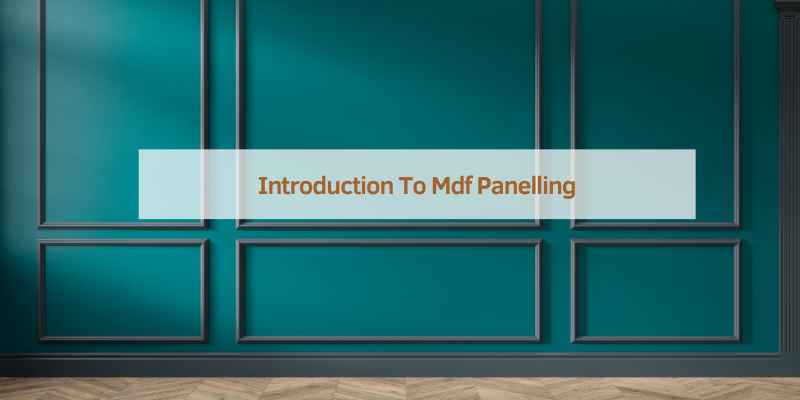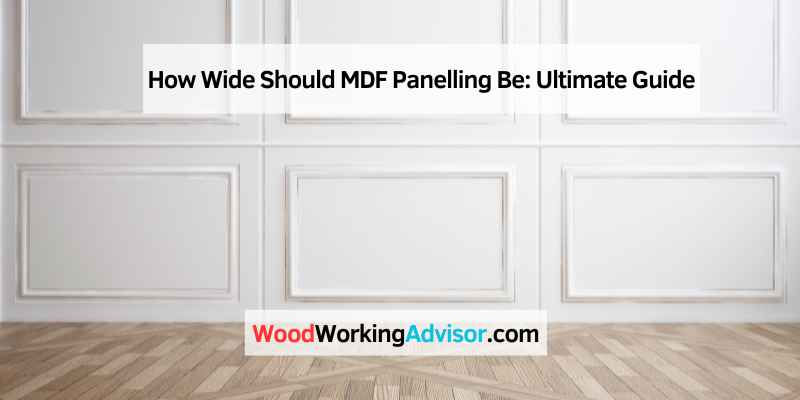MDF panelling should typically be between 3 to 6 inches wide. This range ensures durability and aesthetic appeal.
MDF (Medium Density Fiberboard) panelling is a popular choice for interior wall treatments. It offers a versatile and cost-effective solution for enhancing home decor. Choosing the right width for MDF panels is crucial for achieving a balanced look. Panels that are too wide may dominate the space, while overly narrow panels can appear too busy.
A width of 3 to 6 inches strikes a perfect balance, offering both visual appeal and structural integrity. This range works well in various settings, from modern to traditional interiors. Properly installed MDF panelling can transform a room, adding texture and depth to the walls.
Introduction To Mdf Panelling
MDF panelling is a popular choice for modern homes. MDF stands for Medium Density Fiberboard. It is made from wood fibres and resin. MDF panels are smooth and easy to paint. They can change the look of any room.
Popularity In Home Decor
MDF panelling is very popular in home decor. It adds a stylish touch to walls. Many people choose MDF for its smooth finish. It can fit into any room style. MDF panels are used in living rooms, bedrooms, and kitchens. They can be painted any color. This makes them very versatile.
Benefits Of Using Mdf
There are many benefits of using MDF panels:
- Cost-Effective: MDF is cheaper than solid wood. This makes it a budget-friendly option.
- Easy to Work With: MDF is easy to cut and shape. This makes it ideal for custom designs.
- Smooth Surface: MDF has a smooth surface. This makes it easy to paint and decorate.
- Durable: MDF is strong and lasts a long time. It can withstand daily wear and tear.
- Environmentally Friendly: MDF is made from recycled wood fibres. This makes it an eco-friendly choice.
These benefits make MDF panelling a top choice for home decor projects.

Key Factors Influencing Panel Width
Choosing the right MDF panel width is crucial. This decision impacts the look and feel of your space. Several factors influence the ideal panel width. Below, we explore the key elements to consider.
Room Dimensions
The size of your room plays a significant role. Larger rooms can handle wider panels. They create a bold and sophisticated look. Smaller rooms benefit from narrower panels. These make the space appear larger and more intricate.
Here’s a quick guide:
| Room Size | Recommended Panel Width |
|---|---|
| Small (e.g., bathrooms) | 3 to 4 inches |
| Medium (e.g., bedrooms) | 4 to 6 inches |
| Large (e.g., living rooms) | 6 to 8 inches |
Design Considerations
The design style of your room also matters. Modern designs often use wider panels. They create clean lines and a minimalist look. Traditional designs may use narrower panels. These add detail and texture.
Think about the overall theme. Matching panel width with your design style ensures a cohesive look. Here are some points to consider:
- Modern: Go for 6 to 8-inch panels.
- Traditional: Choose 3 to 5-inch panels.
- Eclectic: Mix widths for a unique look.
These considerations help you decide the perfect MDF panel width. Make sure to measure your room and consider the design style. This ensures a stunning and balanced appearance.
Standard Widths For Mdf Panelling
MDF panelling is a popular choice for both home and commercial interiors. It offers a smooth finish and is easy to work with. The width of MDF panels can vary based on different requirements. Understanding the standard widths can help you make informed decisions for your next project.
Common Measurements
MDF panels come in a variety of standard widths. These widths are designed to meet most project needs. Here are some of the most common measurements:
- 4 inches (100 mm): Ideal for narrow spaces and intricate designs.
- 6 inches (150 mm): A versatile option suitable for various applications.
- 8 inches (200 mm): Perfect for larger spaces and quicker installations.
- 12 inches (300 mm): Used for substantial projects requiring fewer joins.
Custom Sizing Options
Standard sizes may not fit every project’s needs. Custom sizing options are available for MDF panels. This allows you to create unique designs and fit specific spaces.
Here are some common custom sizing options:
- Widths between 3 to 24 inches (75 to 600 mm): Custom widths can be cut to fit any space.
- Special shapes and patterns: Create intricate designs with custom shapes.
- Thickness variations: Choose different thicknesses to add depth and texture.
Custom sizes allow for greater flexibility in design. You can achieve a tailored look that standard sizes can’t offer.
Calculating The Ideal Panel Width
Choosing the right width for MDF paneling can transform your room’s look. The panel width affects both aesthetics and functionality. To make an informed choice, you need to consider several factors. Let’s break down the process.
Determining Room Perimeter
First, measure the room’s perimeter. This helps you figure out how many panels you’ll need.
- Measure each wall’s length.
- Add all lengths together for the total perimeter.
Use a measuring tape for accurate results. Write down each wall’s length to avoid mistakes.
| Wall | Length (feet) |
|---|---|
| Wall 1 | 15 |
| Wall 2 | 10 |
| Wall 3 | 15 |
| Wall 4 | 10 |
Sum the lengths: 15 + 10 + 15 + 10 = 50 feet. This is your room’s perimeter.
Balancing Aesthetics And Practicality
Next, think about your room’s style. Wide panels give a modern look. Narrow panels offer a classic feel.
- For modern rooms, panels 8-12 inches wide work well.
- For classic rooms, panels 4-6 inches wide are ideal.
Balance appearance with ease of installation. Wide panels are quicker to install but may show more seams.
Decide the panel size based on your needs. Use the room’s perimeter to calculate the number of panels required.
For a 50-foot perimeter and 10-inch panels:
- Convert feet to inches: 50 feet = 600 inches.
- Divide by panel width: 600 / 10 = 60 panels.
This method ensures you get the right number of panels and a balanced design.
Installation Tips For Optimal Width
Understanding the optimal width for MDF panelling ensures a professional finish. Proper installation enhances the look and durability of your walls. This guide provides essential tips for achieving the best results.
Preparing Walls
Before installing MDF panels, prepare your walls thoroughly. Ensure the surface is clean, dry, and smooth. Remove any old wallpaper or paint. Fill any holes or cracks with filler. Sand down uneven areas for a flat surface.
| Steps | Tools Needed |
|---|---|
| Clean the walls | Soap, water, sponge |
| Remove old finishes | Scraper, sandpaper |
| Fill holes and cracks | Filler, putty knife |
| Sand the surface | Sandpaper |
Aligning Panels For Symmetry
Aligning panels properly ensures a symmetrical look. Start from the center of the wall and work outwards. Measure the wall to find the center point. Mark this point with a pencil.
- Use a level to draw a vertical line from the ceiling to the floor.
- This line will guide your first panel.
- Ensure each panel aligns with this guide.
Cut panels to fit around windows, doors, and corners. Use a saw to make precise cuts. Always double-check measurements before cutting.
- Measure twice, cut once.
- Place the first panel along the guide line.
- Continue placing panels, ensuring each one is level.
Use spacers to maintain even gaps between panels. This ensures a consistent look. Secure each panel with adhesive and nails.
Design Styles And Panel Width
Choosing the right MDF panelling width is crucial for achieving your desired design style. The width of the panels can significantly influence the overall look of the room. Whether aiming for a traditional or modern aesthetic, understanding how panel width affects design is essential.
Traditional Vs. Modern Looks
Traditional designs often feature wider MDF panels. These wider panels create a classic and timeless look. They evoke a sense of grandeur and elegance.
In contrast, modern designs typically use narrower panels. Narrow panels offer a sleek and contemporary feel. They suit minimalist and clean-lined interiors.
| Design Style | Panel Width |
|---|---|
| Traditional | Wider Panels (6 inches or more) |
| Modern | Narrow Panels (3-4 inches) |
Influence Of Panel Width On Style
The width of MDF panels can dramatically change the room’s atmosphere. Wider panels provide a sense of stability and sophistication. They are perfect for dining rooms, libraries, or any space that benefits from a formal touch.
Narrow panels, on the other hand, add a dynamic and airy feel. They make rooms appear larger and more open. This is ideal for smaller spaces or areas where a modern vibe is desired.
- Wider Panels: Best for traditional, classic styles.
- Narrow Panels: Ideal for modern, contemporary designs.
Choosing the right panel width is key. It helps to set the tone of your interior space. Consider your overall design goals. Then select the panel width that complements your vision.
Maintenance And Durability Considerations
When selecting MDF panelling, it is important to consider maintenance and durability. The width of the panels affects both aspects significantly. Understanding these considerations ensures your panels last longer and stay in top condition.
Impact Of Width On Longevity
The width of MDF panels can impact their longevity. Wider panels may be more prone to warping and bending. Narrower panels tend to be more stable and less likely to deform. It is crucial to choose the right width for your specific needs.
Consider the environment where the panels will be installed. Areas with high humidity require narrower panels. This helps to prevent moisture-related issues. For dry areas, wider panels can be a suitable choice.
Care Tips For Mdf Panels
Proper care extends the life of MDF panels. Here are some practical tips:
- Regular Dusting: Use a soft cloth to remove dust.
- Avoid Water: MDF is sensitive to water. Keep it dry.
- Gentle Cleaning: Use a damp cloth for cleaning. Do not soak.
- Protect from Heat: Keep panels away from direct heat sources.
- Seal Edges: Seal the edges to prevent moisture absorption.
Follow these tips to maintain the appearance and durability of your MDF panels. Regular care ensures they stay looking new and last longer.
Case Studies: Successful Mdf Projects
Exploring the optimal width for MDF panelling can lead to stunning results. Let’s delve into some successful MDF projects. These case studies highlight how the right width can transform spaces, both residential and commercial.
Residential Applications
In residential settings, MDF panelling can create a cozy and elegant atmosphere. Take the Smith family’s living room. They opted for 4-inch wide panels. This width provided a balanced look, enhancing the room’s aesthetic without overwhelming it.
Another example is the Johnsons’ bedroom. They chose 6-inch wide panels for their feature wall. The wider panels added a modern touch, making the room feel more spacious and stylish. The Johnsons were delighted with the transformation.
| Project | Width of MDF Panels | Outcome |
|---|---|---|
| Smith Living Room | 4 inches | Balanced and Elegant |
| Johnsons’ Bedroom | 6 inches | Modern and Spacious |
Commercial Spaces
In commercial spaces, the right MDF panel width can elevate the environment. Consider the Baker Café. They used 3-inch wide panels for their walls. This choice created a warm and inviting atmosphere for their customers.
Another successful project is the Green Office. They implemented 5-inch wide panels in their meeting rooms. This width gave the rooms a professional and sleek look. Employees and clients appreciated the modern and clean design.
| Project | Width of MDF Panels | Outcome |
|---|---|---|
| Baker Café | 3 inches | Warm and Inviting |
| Green Office | 5 inches | Professional and Sleek |
These case studies show the impact of choosing the right MDF panel width. Whether for a home or a business, the right width can make all the difference.
Final Thoughts On Choosing Mdf Width
Choosing the right width for MDF panelling can be tricky. It involves balancing aesthetics and functionality. The right width can enhance a room’s appearance and feel. But how do you decide? Let’s explore some key considerations to help you make an informed choice.
Personal Preference
Your taste plays a significant role in selecting MDF width. Some people prefer narrow panels. They can create a classic look in any room. Others lean towards wider panels. They often provide a modern and clean appearance.
Consider the room’s size and style. A small room might benefit from narrower panels. They can make the space feel larger. Wider panels can make a large room feel more cozy. Always go with what feels right for you.
Consulting With Professionals
Sometimes, it’s wise to seek expert advice. Professional designers can offer valuable insights. They have experience with different panel widths. They know what works best in various settings.
Consulting with a contractor is also beneficial. They understand the installation process. They can suggest the most suitable width for your needs. This ensures that the panelling is both beautiful and practical.
Here’s a quick comparison table to help you decide:
| Room Size | Recommended Panel Width |
|---|---|
| Small | 2-4 inches |
| Medium | 4-6 inches |
| Large | 6-8 inches |
Keep these factors in mind. Whether you prefer narrow or wide panels, make sure they suit your space. And don’t hesitate to consult professionals for the best results.

Frequently Asked Questions
What Is The Best Width For Paneling Mdf?
The best width for paneling MDF typically ranges from 4 to 8 inches. This size offers a balanced look and easy installation.
How Wide Apart Should Panelling Be?
Paneling should typically be spaced 16 to 24 inches apart. This ensures proper support and a balanced appearance.
How To Work Out How Much Mdf For Panelling?
Measure the wall’s height and width. Calculate the total area in square meters. Divide by the MDF panel size. Buy extra for cuts and mistakes.
What Are The Dimensions Of Wall Panelling?
Wall panelling dimensions vary widely. Common sizes include 4×8 feet sheets and planks from 3 to 12 inches wide. Custom sizes available.
Conclusion
Choosing the right width for MDF panelling enhances your room’s aesthetic. Consider the room size and design style. Narrow panels suit modern spaces, while wider panels fit traditional looks. Always ensure precision in measurements. With these tips, your MDF panelling project will achieve a stunning and cohesive finish.

